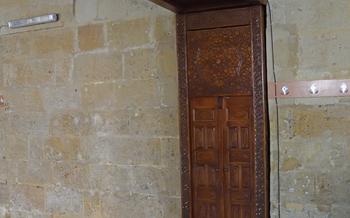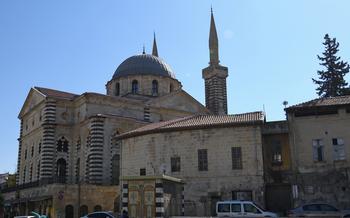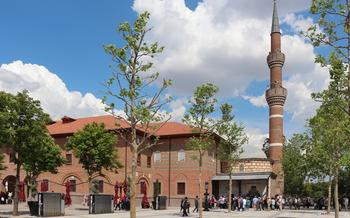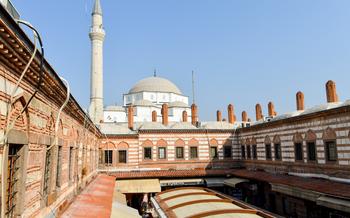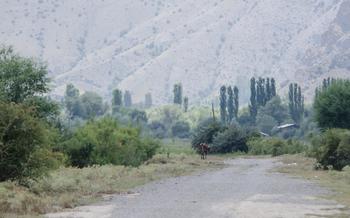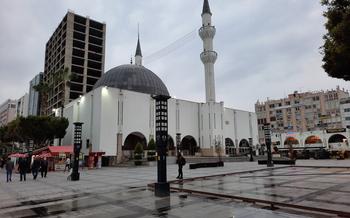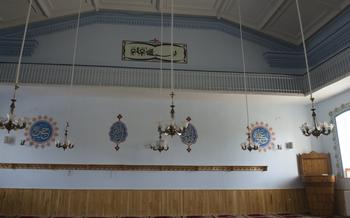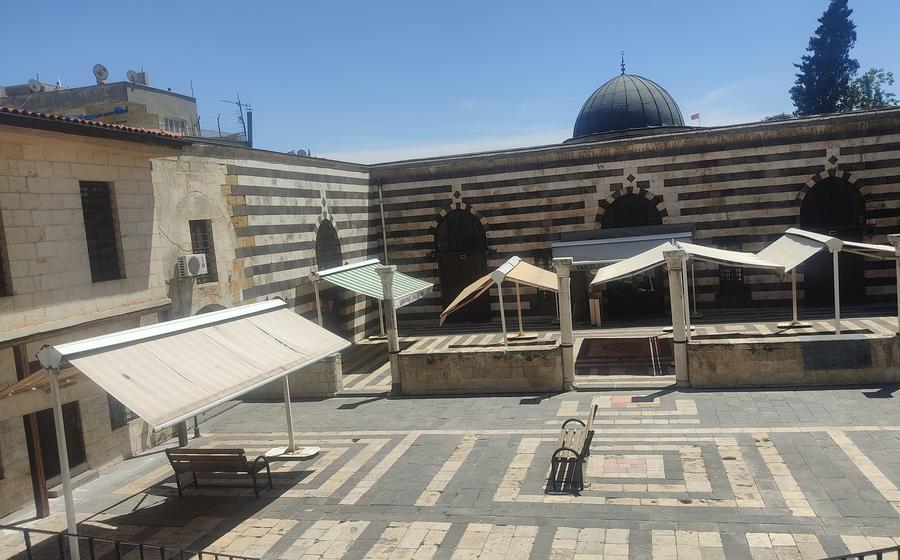
Şirvani Mosque (Şirvani Mehmet Efendi Mosque)
- Şirvani Mosque: A Masterpiece of Architecture
- Exploring the Mosque's Interior
- Marveling at the Exterior Beauty
- A Place of Worship and Community
- Unveiling the History of Construction
- Admiring the Calligraphy and Inscriptions
- Discovering the Unique Mihrab
- Appreciating the Domed Ceiling
- Witnessing the Call to Prayer
- Learning about Restoration Efforts
- Gaziantep's Culinary Delights
- Insider Tip: Hidden Gems Nearby
Şirvani Mosque: A Masterpiece of Architecture
The Şirvani Mosque, a magnificent edifice in the heart of Gaziantep, stands as a testament to the city's rich history and architectural prowess. Built in the 17th century, the mosque is named after its founder, Şirvani Mehmet Efendi, a prominent scholar and statesman who played a pivotal role in the development of Gaziantep.
Crafted with meticulous precision, the mosque embodies the essence of Ottoman architecture, seamlessly blending traditional Islamic elements with regional influences. Its striking facade, adorned with intricate carvings and calligraphy, beckons visitors to step inside and marvel at its splendor. The elegant minarets, reaching towards the heavens, serve as a symbol of faith and devotion, while the spacious courtyard provides a tranquil oasis amidst the bustling city.
As a cultural landmark, the Şirvani Mosque holds immense significance for Gaziantep. It represents the city's commitment to preserving its heritage and showcasing its architectural prowess. The mosque serves as a gathering place for the community, fostering a sense of unity and belonging among the locals.
Exploring the Mosque's Interior
The interior of the Şirvani Mosque is a testament to the mosque's rich history and architectural significance. The mosque's layout follows the traditional Ottoman style, with a rectangular prayer hall and a domed central space. The prayer hall is divided into three naves by rows of columns, which support the mosque's impressive dome.
The interior of the mosque is decorated with intricate tilework, calligraphy, and stained-glass windows. The walls are adorned with verses from the Quran and the names of Allah and the Prophet Muhammad. The mihrab, or prayer niche, is particularly impressive, with its intricate carvings and colorful tiles.
The mosque's interior is a serene and spiritual space, conducive to contemplation and prayer. Visitors can often be seen sitting in quiet contemplation, or performing their prayers in the tranquil atmosphere of the mosque. The mosque is also a popular destination for Islamic scholars and pilgrims, who come to study and pray in this historic and sacred space.
Marveling at the Exterior Beauty
The Şirvani Mosque stands as a testament to the architectural prowess of the Ottoman era. Its facade is a symphony of intricate details, with the entrance portal taking center stage. This grand entrance features an impressive archway adorned with stunning carvings and calligraphy. The arch is flanked by two slender minarets, their graceful silhouettes reaching towards the sky, providing a striking contrast to the dome's gentle curves.
The exterior walls of the mosque are adorned with a rich tapestry of decorative elements. Intricate geometric patterns, floral motifs, and verses from the Quran are meticulously carved into the stone, creating a mesmerizing visual symphony. The interplay of light and shadow on these intricate carvings adds a dynamic dimension to the mosque's exterior, making it a true masterpiece of Islamic art.
The Şirvani Mosque's strategic location in the heart of Gaziantep's old city further enhances its visual impact. Surrounded by a vibrant tapestry of narrow streets and traditional Ottoman-era houses, the mosque's majestic dome and minarets dominate the skyline, serving as a beacon of faith and architectural splendor for all who behold it.
A Place of Worship and Community
The Şirvani Mosque stands as a symbol of unity and a center of worship for the Muslim community in Gaziantep. As a sacred space, it invites the faithful to gather, pray, and connect with their spiritual side. The mosque's serene atmosphere provides a sanctuary for contemplation and reflection, allowing visitors to find solace and tranquility within its walls.
Beyond its religious significance, the mosque serves as a hub for community gatherings and events. Throughout the year, the mosque hosts lectures, seminars, and workshops that promote Islamic education and foster a sense of community among the locals. These events provide opportunities for people to come together, share knowledge, and strengthen their bonds.
The mosque's role as a community center extends beyond religious activities. It also serves as a venue for social gatherings, celebrations, and charitable initiatives. The mosque's courtyard and facilities are often used for hosting iftars during Ramadan, organizing charity drives, and providing assistance to those in need.
Through its various functions, the Şirvani Mosque plays a vital role in fostering a sense of unity and belonging among the people of Gaziantep. It is a place where the community comes together to celebrate their faith, share their experiences, and support one another, creating a vibrant and inclusive social environment.
Unveiling the History of Construction
The construction of the Şirvani Mosque was initiated in the year 1627 during the reign of Sultan Murad IV. The mastermind behind this architectural marvel was Mehmed Ağa, an accomplished architect of the Ottoman era. The construction process faced numerous challenges, primarily due to the complex and intricate design of the mosque. The builders had to meticulously execute each element, from the towering minarets to the intricate calligraphy adorning the interior. Despite the difficulties encountered, the mosque was finally completed in 1638, standing as a testament to the perseverance and artistry of its creators.
Admiring the Calligraphy and Inscriptions
The art of calligraphy holds a profound significance in Islamic culture, serving as a means to transcribe and beautify the sacred texts of the Quran. At the Şirvani Mosque, visitors are captivated by the exquisite calligraphy adorning the walls, pillars, and mihrab. The intricate verses and phrases, meticulously inscribed in elegant Arabic script, create a mesmerizing visual symphony.
The calligraphy at the Şirvani Mosque is not merely decorative; it carries deep spiritual and symbolic meaning. Each letter and word is carefully chosen and arranged to convey a message or evoke a specific emotion. Verses from the Quran, praises to the Prophet Muhammad, and invocations for blessings are among the common themes found in these inscriptions.
As visitors gaze upon the calligraphy, they are reminded of the rich history and heritage of Islamic art. The verses and phrases inscribed within the mosque's walls serve as a testament to the skill and artistry of the calligraphers who created them. These inscriptions not only enhance the beauty of the mosque but also provide a glimpse into the spiritual and intellectual world of the Muslim community.
Discovering the Unique Mihrab
The mihrab, a sacred niche in a mosque that indicates the direction of Mecca, holds immense significance in Islamic architecture. The Şirvani Mosque boasts an exquisite mihrab that showcases the pinnacle of craftsmanship and artistry. Intricately carved from a single block of stone, the mihrab is adorned with mesmerizing arabesque patterns, geometric motifs, and elegant calligraphy.
The mihrab's design exudes a sense of grandeur and devotion. Its pointed arch frames a beautifully decorated niche, creating a focal point that draws the eyes and inspires a sense of reverence. The intricate carvings and calligraphy seem to dance harmoniously, creating a symphony of visual delight.
Beyond its aesthetic beauty, the mihrab serves as a reminder of the mosque's spiritual significance. It represents the connection between the earthly realm and the divine, inviting worshippers to focus their prayers and intentions towards Mecca. The mihrab's presence adds a profound sense of sanctity to the mosque, making it a cherished destination for both locals and visitors seeking spiritual fulfillment.
Appreciating the Domed Ceiling
The Şirvani Mosque showcases a magnificent domed ceiling that exemplifies the architectural prowess of Islamic design. The dome, a defining feature of Islamic architecture, symbolizes the heavens and the unity of God. Its grand scale and intricate decorations create a sense of awe and spirituality within the mosque.
The dome's interior is embellished with vibrant and intricate patterns, invoking a sense of celestial beauty. The harmonious blend of colors and shapes adds to the mosque's overall grandeur. The dome's height accentuates the spaciousness of the prayer hall, allowing natural light to flood in, casting a warm and ethereal glow upon the interior.
One cannot help but admire the architectural mastery behind the dome's construction. Its perfect symmetry and balance demonstrate the ingenuity of the mosque's builders. The dome stands as a testament to the enduring legacy of Islamic architecture, blending artistic expression with religious devotion.
Witnessing the Call to Prayer
At the appointed hour, a hush falls over the bustling streets of Gaziantep as the rhythmic chanting of the muezzin echoes through the air, signaling the call to prayer. This melodious invocation, reverberating from the minarets of the Şirvani Mosque, invites the faithful to come together and fulfill their religious obligations.
The call to prayer, a sacred tradition in Islam, holds immense significance for the Muslim community. It is a reminder of their connection with the divine and a call to pause and reflect on their spiritual journey. As the muezzin's voice fills the air, passersby stop in their tracks, turning their faces towards the mosque in reverence.
Inside the mosque, worshippers gather in the tranquil prayer hall, their hearts and minds attuned to the divine. The rhythmic chant, echoing through the centuries-old walls, envelops them in a spiritual aura, creating a profound sense of serenity and devotion.
Whether you are a Muslim or not, witnessing the call to prayer at the Şirvani Mosque is a unique and moving experience. It offers a glimpse into the rich Islamic traditions of Gaziantep and the deep faith that permeates the city's soul.
Learning about Restoration Efforts
Over the years, the Şirvani Mosque has undergone several restoration projects to preserve its architectural integrity and historical value. The need for conservation arose due to the mosque's age, exposure to elements, and the effects of past conflicts in the region.
One of the most significant restoration efforts took place in the early 21st century, led by a team of experts in Islamic architecture. The project aimed to address structural issues, repair damaged elements, and restore the mosque's original splendor. Challenges faced during the restoration included sourcing authentic materials, adhering to traditional techniques, and ensuring minimal disruption to the mosque's daily functions.
The successful preservation of the Şirvani Mosque's heritage is a testament to the dedication of the restoration team and the importance placed on preserving cultural landmarks. The mosque stands as a living example of Gaziantep's rich history and continues to inspire and captivate visitors with its timeless beauty and spiritual significance.
Gaziantep's Culinary Delights
A visit to Gaziantep is incomplete without savoring its exceptional cuisine. The city is renowned for its rich culinary heritage and delectable dishes that have gained international acclaim. Gaziantep's cuisine reflects a harmonious blend of Turkish, Arabic, and Kurdish influences, creating a unique and unforgettable gastronomic experience.
Baklava, with its layers of filo pastry, chopped nuts, and sweet syrup, is a must-try delicacy. Every bite offers a symphony of flavors and textures that will tantalize your taste buds. Gaziantep is also famous for its kebabs, grilled meats that are marinated in aromatic spices and cooked to perfection. The "Ali Nazik Kebabı," made with tender lamb meat and topped with a spicy tomato sauce and yogurt, is a local favorite.
To fully immerse yourself in Gaziantep's culinary scene, consider joining a food tour. These tours take you to hidden gems and local eateries, allowing you to sample a variety of dishes and learn about the city's rich culinary traditions.
Recommended Restaurants:
- İmam Çağdaş: Renowned for its traditional Turkish cuisine, this restaurant offers a delightful ambiance and delectable dishes, including the famous "beyran," a lamb soup with rice.
- Antepfıstığı: Experience authentic Gaziantep cuisine in a warm and inviting setting. Their menu features an array of local specialties, including "yuvalama," a hearty stew with meatballs and rice.
- Katmerci Zekeriya Usta: Indulge in the city's signature dessert, "katmer," a crispy pastry filled with nuts and cheese. This traditional sweet treat is a must-try for any visitor to Gaziantep.
Insider Tip: Hidden Gems Nearby
While the Şirvani Mosque is a must-visit attraction in Gaziantep, the city offers a treasure trove of hidden gems waiting to be discovered. Just a short stroll from the mosque, visitors can delve into the heart of the old city, where narrow cobblestone streets wind their way past historical landmarks, vibrant markets, and traditional Turkish coffeehouses. Explore the Gaziantep Zeugma Mosaic Museum, home to a stunning collection of ancient Roman mosaics. Marvel at the intricate stone carvings adorning the Taşhan, a 17th-century caravanserai that once served as a trading hub. Indulge in the flavors of Gaziantep's renowned cuisine at local restaurants, savoring mouthwatering kebabs, baklava, and other culinary delights. By combining your visit to the Şirvani Mosque with a broader Gaziantep itinerary, you'll uncover the city's rich history, vibrant culture, and hidden treasures that will leave you captivated.
